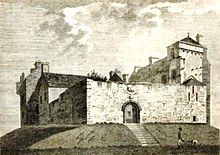Kenmure Castle
Kenmure Castle is the ruined country house in The Glenkens , about 1 mile south of New Galloway in the Scottish administrative division of Dumfries and Galloway . The site has been inhabited since the Middle Ages. Today's house contains parts of the previous building from the 17th century and was rebuilt in the 19th century. It has been in decline since the middle of the 20th century. There was the seat of the Gordon family from Lochinvar , who later rose to the nobility as Viscounts of Kenmure . Historic Scotland has listed Kenmure Castle as a Category B Historic Building and is a Scheduled Monument .
history
The present country house stands on a partially natural mound , which may have been modified for defensive purposes in the early Middle Ages. The Lords of Galloway , rulers of a partially independent kingdom in southwestern Scotland until the 13th century, could have had a fortress built there. Kenmure Castle was one of the possible birthplaces of John Balliol , later King of Scotland, whose mother was Dervorguilla , a daughter of Alan, Lord of Galloway , the last independent ruler of Galloway, in 1249 . It later belonged to the Douglas and Maxwell families .
Kenmure became the property of the Gordon family of Berwickshire in 1297 . Around 1450 part of the Gordon family settled in the region and had a castle built on an island in Lochinvar, about 10 km north. An early castle that stood here was destroyed or damaged by opponents of Mary Queen of Scots who marched through the southwest after defeating Mary's supporters at the Battle of Langside in 1568 .
Sir Robert Gordon of Lochinvar was made baronet in 1626 and King Charles I of Scotland made his son John Viscount of Kenmure in 1633. The core of the current building is the castle, which was mostly built in the 17th century, although it may have contained older parts of the building. The buildings ran along the west and south sides of an inner courtyard, while the north and east sides were formed by high walls. The entrance gate in the north wall was flanked by towers at the two northern corners. The 6th Viscount took part in the Jacobite revolt in 1715, was subsequently beheaded and had forfeited his lands to the crown. Kenmure Castle is described as a ruin as early as 1790.
In 1824, Captain John Gordon was regained the title of Viscount, but after the death of his nephew and heir, the 8th Viscount, in 1847 he rests again. The castle was significantly rebuilt in the 19th century and modernized into a country house. The courtyard wall and the northeast tower were blown up. The southern building line was rebuilt around 1840 and in 1879 the architect Matthew Ellison Hadfield from Sheffield was commissioned to convert the western building line. Further extensions were made in 1908. Around 1958 the building was partially demolished and the roof removed. The remains of the country house were added to the List of Historic Buildings in 1971 and have been a Scheduled Monument since 1998 .
A sundial from Kenmure Castle is now in the Dumfries Museum .
Individual evidence
- ↑ a b Listed Building - Entry . In: Historic Scotland .
- ↑ a b c d Scheduled Monument - entry . In: Historic Scotland .
- ↑ a b c Kenmure Castle . Royal Commission on the Ancient and Historical Monuments of Scotland. Retrieved September 27, 2017.
- ^ A b Francis Grose: The antiquities of Scotland . Pp. 189-190. 1797. Retrieved September 27, 2017.
- ↑ William MacMath: William de Gordon . In: James Balfour Paul (Ed.): The Scots Peerage . tape 5 : Innermeath-Mar . David Douglas, Edinburgh 1908, p. 98–99 (English, Textarchiv - Internet Archive ).
- ↑ William MacMath: William de Gordon . In: James Balfour Paul (Ed.): The Scots Peerage . tape 5 : Innermeath-Mar . David Douglas, Edinburgh 1908, p. 100-102 (English, Textarchiv - Internet Archive ).
- ↑ Lochinvar Castle . Royal Commission on the Ancient an Historical Monuments of Scotland. Retrieved September 27, 2017.
- ^ A b David McGibbon, Thomas Ross: The castellated and domestic architecture of Scotland . David Douglas, Edinburgh 1887. pp. 256-260.
- ↑ a b Kenmure Castle . In: Dictionary of Scottish Architects . Retrieved September 27, 2017.
Web links
Coordinates: 55 ° 3 '47.9 " N , 4 ° 8' 16.8" W.



